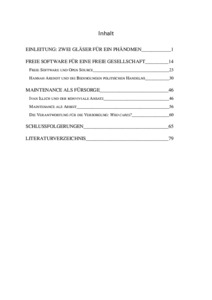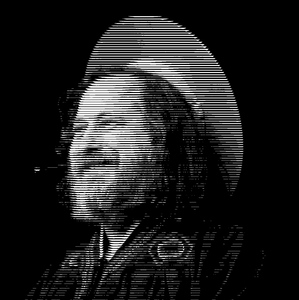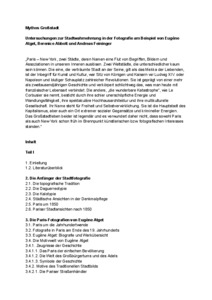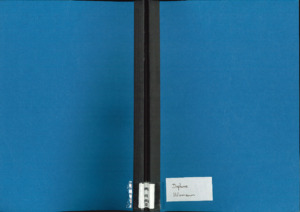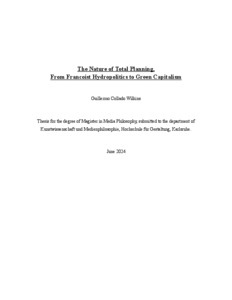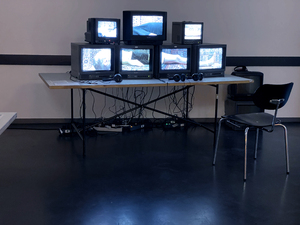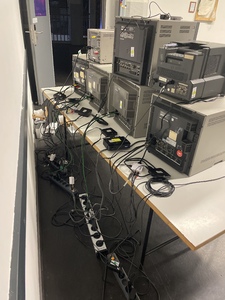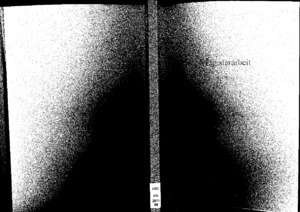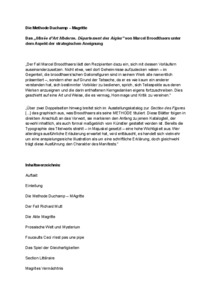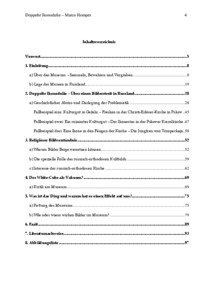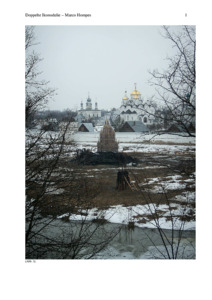"Kunstwissenschaft und Medienphilosophie"
| Begriff | Kunstwissenschaft und Medienphilosophie |
| Metakey | Fachgruppe (institution:field_of_study) |
| Typ | Keyword |
| Vokabular | HfG |
50 Inhalte
- Seite 1 von 5
Inhaltverzeichnis - Who cares?
- Titel
- Inhaltverzeichnis - Who cares?
- Titel (en)
- Who cares?
- Untertitel des Projekts/Werks (en)
- Digital sociality, care infrastructure and convivial technology
- Autor/in
- Beschreibung (de)
- Die Hackerkultur verbindet Theorie und Praxis (nach hand-on Prinzipien) und einen neuen Ansatz für Kulturmaterialien (»information wants to be free«), der nicht nur eine andere Epistemologie, sondern auch einen neuen politischen Diskurs über Digitalität, Geräte und Menschen impliziert. Das Verhältnis zwischen Technik und Politik dieser Gruppe wird im ersten Kapitel analysiert: Zuerst wird die Entstehung proprietärer Software betrachtet, dann die Unterschiede zwischen Open Source und freier Software, und wie im letzten die Privateigentum und die soziale Beziehung zwischen Programmen, Benutzern und Entwicklern radikal in Frage gestellt werden. Später wird diese Beziehung anhand von Hanna Arendts _Die conditio humana_ in Bezug auf Arbeit, Herstellen und Handlen, Notwendigkeit und Freiheit, die die Bedingungen für Politik schaffen, weiter diskutiert. Im zweiten Kapitel wird das Konzept der Konvivialität (Ivan Illich) vorgestellt und diskutiert. Diese Idee wird später in der Wartung als infrastrukturelle Vorsorge weiterentwickelt und als ein zentrales Element digitaler Technologien vorgeschlagen, das weiter diskutiert werden sollte. Diese Konstellation des Denkens und Handelns, des Spielens und Lernens, des Experimentierens und der Übernahme von Verantwortung sowie der Politik und der sozialen Beziehungen sollte in der Technologiedebatte eine wichtige Rolle spielen.
- Beschreibung (en)
- Hacker culture connects theory and praxis (following hand-on principles) and a new approach to culture materials (»information wants to be free«), that implies not only a different epistemology, but also a new political discourse on digitality, devices, and people. The relation between technic and politic of this group is analyzed in the first chapter: first focusing on the emergence of proprietary software; then considering the differences between open source and free software, the last one challenging radically the notion of private property and the social relation among programs, users, and developers. Later on, reading Hanna Arendts "The Human condition", the relation will be further discussed in terms of labor, work and action, necessity and freedom, which establish the conditions for politics. In the second chapter, the concept of conviviality (Ivan Illich) is introduced and discussed. This idea is later developed in maintenance as infrastructural care and proposed as a central element of digital technologies that should be further discussed. This constellation of thinking and acting, playing and learning, experimenting and taking responsibility, as well as politics and social relations should play a prominent role in the debate about technology.
- Typ des Projekts/Werks
- Schlagworte
- Datierung
- 30.09.2023
- Sprache
- Titel
- Inhaltverzeichnis - Who cares?
- Titel (en)
- Index- Who Cares
- Urheberrechtshinweis
- Víctor Fancelli Capdevila
- Rechtsschutz/Lizenz
- Freigabe Nutzung HfG
- Medienersteller/in
- Beziehung/Funktion
- Medien-Beschreibung
- Inhaltverzeichnis von Who Cares?
- Medien-Beschreibung (en)
- Index of Who cares?
- Projektleiter/in
- Semester
- Studiengang
- Typ der Abschlussarbeit
- Importiert am
- 02.06.2024
- Übergeordnete Sets
- 1
St IGNUtius
- Titel
- St IGNUtius
- Titel (en)
- Who cares?
- Untertitel des Projekts/Werks (en)
- Digital sociality, care infrastructure and convivial technology
- Autor/in
- Beschreibung (de)
- Die Hackerkultur verbindet Theorie und Praxis (nach hand-on Prinzipien) und einen neuen Ansatz für Kulturmaterialien (»information wants to be free«), der nicht nur eine andere Epistemologie, sondern auch einen neuen politischen Diskurs über Digitalität, Geräte und Menschen impliziert. Das Verhältnis zwischen Technik und Politik dieser Gruppe wird im ersten Kapitel analysiert: Zuerst wird die Entstehung proprietärer Software betrachtet, dann die Unterschiede zwischen Open Source und freier Software, und wie im letzten die Privateigentum und die soziale Beziehung zwischen Programmen, Benutzern und Entwicklern radikal in Frage gestellt werden. Später wird diese Beziehung anhand von Hanna Arendts _Die conditio humana_ in Bezug auf Arbeit, Herstellen und Handlen, Notwendigkeit und Freiheit, die die Bedingungen für Politik schaffen, weiter diskutiert. Im zweiten Kapitel wird das Konzept der Konvivialität (Ivan Illich) vorgestellt und diskutiert. Diese Idee wird später in der Wartung als infrastrukturelle Vorsorge weiterentwickelt und als ein zentrales Element digitaler Technologien vorgeschlagen, das weiter diskutiert werden sollte. Diese Konstellation des Denkens und Handelns, des Spielens und Lernens, des Experimentierens und der Übernahme von Verantwortung sowie der Politik und der sozialen Beziehungen sollte in der Technologiedebatte eine wichtige Rolle spielen.
- Beschreibung (en)
- Hacker culture connects theory and praxis (following hand-on principles) and a new approach to culture materials (»information wants to be free«), that implies not only a different epistemology, but also a new political discourse on digitality, devices, and people. The relation between technic and politic of this group is analyzed in the first chapter: first focusing on the emergence of proprietary software; then considering the differences between open source and free software, the last one challenging radically the notion of private property and the social relation among programs, users, and developers. Later on, reading Hanna Arendts "The Human condition", the relation will be further discussed in terms of labor, work and action, necessity and freedom, which establish the conditions for politics. In the second chapter, the concept of conviviality (Ivan Illich) is introduced and discussed. This idea is later developed in maintenance as infrastructural care and proposed as a central element of digital technologies that should be further discussed. This constellation of thinking and acting, playing and learning, experimenting and taking responsibility, as well as politics and social relations should play a prominent role in the debate about technology.
- Typ des Projekts/Werks
- Schlagworte
- Datierung
- 30.09.2023
- Sprache
- Titel
- St IGNUtius
- Titel (en)
- St IGNUtius
- Urheberrechtshinweis
- Víctor Fancelli Capdevila. Remix of an image By Anders Brenna, CC BY 3.0
- Rechtsschutz/Lizenz
- Freigabe Nutzung HfG
- Medienersteller/in
- Beziehung/Funktion
- Medien-Beschreibung
- Remix eines Bildes von Richard Stallman, dem Gründer des GNU-Projekts und Verfechter freier Software, in der Rolle des Heiligen IGNUtius. Oslo, Norwegen, 23. Februar 2009
- Medien-Beschreibung (en)
- Remix of an image of Richard Stallman, founder of the GNU project and free software advocate, cosplaying St. IGNUtius. Oslo, Norway, 23 February 2009
- Alternativ-Text (de)
- Schwarz-weißes Bild eines bärtigen Mannes (Richard Stallman), der eine runde Scheibe als Hut trägt, die an den Heiligenschein der Heiligen erinnert.
- Alternativ-Text (en)
- Black and white image of a bearded man (Richard Stallman), wearing a round disc as a hat, reminiscent of the halo of the saints.
- Projektleiter/in
- Semester
- Studiengang
- Typ der Abschlussarbeit
- Importiert am
- 02.06.2024
- Übergeordnete Sets
- 1
Kurzbeschreibung von Who cares?
- Titel
- Kurzbeschreibung von Who cares?
- Titel (en)
- Who cares?
- Untertitel des Projekts/Werks (en)
- Digital sociality, care infrastructure and convivial technology
- Autor/in
- Beschreibung (de)
- Die Hackerkultur verbindet Theorie und Praxis (nach hand-on Prinzipien) und einen neuen Ansatz für Kulturmaterialien (»information wants to be free«), der nicht nur eine andere Epistemologie, sondern auch einen neuen politischen Diskurs über Digitalität, Geräte und Menschen impliziert. Das Verhältnis zwischen Technik und Politik dieser Gruppe wird im ersten Kapitel analysiert: Zuerst wird die Entstehung proprietärer Software betrachtet, dann die Unterschiede zwischen Open Source und freier Software, und wie im letzten die Privateigentum und die soziale Beziehung zwischen Programmen, Benutzern und Entwicklern radikal in Frage gestellt werden. Später wird diese Beziehung anhand von Hanna Arendts _Die conditio humana_ in Bezug auf Arbeit, Herstellen und Handlen, Notwendigkeit und Freiheit, die die Bedingungen für Politik schaffen, weiter diskutiert. Im zweiten Kapitel wird das Konzept der Konvivialität (Ivan Illich) vorgestellt und diskutiert. Diese Idee wird später in der Wartung als infrastrukturelle Vorsorge weiterentwickelt und als ein zentrales Element digitaler Technologien vorgeschlagen, das weiter diskutiert werden sollte. Diese Konstellation des Denkens und Handelns, des Spielens und Lernens, des Experimentierens und der Übernahme von Verantwortung sowie der Politik und der sozialen Beziehungen sollte in der Technologiedebatte eine wichtige Rolle spielen.
- Beschreibung (en)
- Hacker culture connects theory and praxis (following hand-on principles) and a new approach to culture materials (»information wants to be free«), that implies not only a different epistemology, but also a new political discourse on digitality, devices, and people. The relation between technic and politic of this group is analyzed in the first chapter: first focusing on the emergence of proprietary software; then considering the differences between open source and free software, the last one challenging radically the notion of private property and the social relation among programs, users, and developers. Later on, reading Hanna Arendts "The Human condition", the relation will be further discussed in terms of labor, work and action, necessity and freedom, which establish the conditions for politics. In the second chapter, the concept of conviviality (Ivan Illich) is introduced and discussed. This idea is later developed in maintenance as infrastructural care and proposed as a central element of digital technologies that should be further discussed. This constellation of thinking and acting, playing and learning, experimenting and taking responsibility, as well as politics and social relations should play a prominent role in the debate about technology.
- Typ des Projekts/Werks
- Schlagworte
- Datierung
- 30.09.2023
- Sprache
- Titel
- Kurzbeschreibung von Who cares?
- Titel (en)
- Project descritption of Who Cares?
- Urheberrechtshinweis
- Víctor Fancelli Capdevila
- Rechtsschutz/Lizenz
- Freigabe Nutzung HfG
- Medienersteller/in
- Beziehung/Funktion
- Medien-Beschreibung
- Zusammenfassung des Projekts Who cares?
- Projektleiter/in
- Semester
- Studiengang
- Typ der Abschlussarbeit
- Importiert am
- 02.06.2024
- Übergeordnete Sets
- 1
Mythos Großstadt
- Titel
- Mythos Großstadt
- Untertitel
- Untersuchungen zur Stadtwahrnehmung in der Fotografie am Beispiel von Eugène Atget, Berenice Abbott und Andreas Feininger
- Autor/in
- Beschreibung (de)
- „Paris – New York, zwei Städte, deren Namen eine Flut von Begriffen, Bildern und Assoziationen in unserem Inneren auslösen. Zwei Weltstädte, die unterschiedlicher kaum sein können. Die eine, die verträumte Stadt an der Seine, gilt als das Mekka der Liebenden, ist der Inbegriff für Kunst und Kultur, war Sitz von Königen und Kaisern wir Ludwig XIV. oder Napoleon und blutiger Schauplatz zahlreicher Revolutionen. Sie ist geprägt von einer mehr als zweitausendjährigen Geschichte und verkörpert schlichtweg das, was man heute mit französischer Lebensart verbindet. Die andere, 'die wunderbare Katastrophe', wie Le Corbusier sie nennt, besticht durch ihre schier unerschöpfliche Energie und Wandlungsfähigkeit, ihre spektakuläre Hochhausarchitektur und ihre multikulturelle Gesellschaft. Ihr Name steht für Freiheit und Selbstverwirklichung. Sie ist die Hauptstadt des Kapitalismus, aber auch ein Ort extremer sozialer Gegensätze und krimineller Energien.
Das Großstadtleben beider ist legendär und es verwundert daher nicht, dass sowohl Paris als auch New York schon früh im Brennpunkt künstlerischen bzw. fotografischen Interesses standen.”
- „Paris – New York, zwei Städte, deren Namen eine Flut von Begriffen, Bildern und Assoziationen in unserem Inneren auslösen. Zwei Weltstädte, die unterschiedlicher kaum sein können. Die eine, die verträumte Stadt an der Seine, gilt als das Mekka der Liebenden, ist der Inbegriff für Kunst und Kultur, war Sitz von Königen und Kaisern wir Ludwig XIV. oder Napoleon und blutiger Schauplatz zahlreicher Revolutionen. Sie ist geprägt von einer mehr als zweitausendjährigen Geschichte und verkörpert schlichtweg das, was man heute mit französischer Lebensart verbindet. Die andere, 'die wunderbare Katastrophe', wie Le Corbusier sie nennt, besticht durch ihre schier unerschöpfliche Energie und Wandlungsfähigkeit, ihre spektakuläre Hochhausarchitektur und ihre multikulturelle Gesellschaft. Ihr Name steht für Freiheit und Selbstverwirklichung. Sie ist die Hauptstadt des Kapitalismus, aber auch ein Ort extremer sozialer Gegensätze und krimineller Energien.
- Beschreibung (en)
- "Paris - New York, two cities whose names trigger a flood of concepts, images and associations within us. Two cosmopolitan cities that could hardly be more different. One, the dreamy city on the Seine, is considered the Mecca of lovers, is the epitome of art and culture, was the seat of kings and emperors such as Louis XIV and Napoleon and the bloody scene of numerous revolutions. It is characterized by more than two thousand years of history and simply embodies what is associated with the French way of life today. The other, 'the marvelous catastrophe', as Le Corbusier called it, captivates with its sheer inexhaustible energy and adaptability, its spectacular high-rise architecture and its multicultural society. Its name stands for freedom and self-realization. It is the capital of capitalism, but also a place of extreme social contrasts and criminal energy.
The big city life of both is legendary and it is therefore not surprising that both Paris and New York were the focus of artistic and photographic interest early on."
- "Paris - New York, two cities whose names trigger a flood of concepts, images and associations within us. Two cosmopolitan cities that could hardly be more different. One, the dreamy city on the Seine, is considered the Mecca of lovers, is the epitome of art and culture, was the seat of kings and emperors such as Louis XIV and Napoleon and the bloody scene of numerous revolutions. It is characterized by more than two thousand years of history and simply embodies what is associated with the French way of life today. The other, 'the marvelous catastrophe', as Le Corbusier called it, captivates with its sheer inexhaustible energy and adaptability, its spectacular high-rise architecture and its multicultural society. Its name stands for freedom and self-realization. It is the capital of capitalism, but also a place of extreme social contrasts and criminal energy.
- Kategorie
- Typ des Projekts/Werks
- Schlagworte
- Datierung
- 2003
- Sprache
- Ort: Institution
- Stadt
- Titel
- Mythos Großstadt
- Urheberrechtshinweis
- © Daphne Noee
- Rechtsschutz/Lizenz
- Freigabe Nutzung HfG
- Medienersteller/in
- Beziehung/Funktion
- Projektleiter/in
- Semester
- Studiengang
- Typ der Abschlussarbeit
- Archiv-Signatur
- HfG HS 2003 02
- Externes Archiv
- Importiert am
- 16.06.2024
- Übergeordnete Sets
- 1
Deckblatt Mythos Großstadt
- Titel
- Deckblatt Mythos Großstadt
- Autor/in
- Kategorie
- Schlagworte
- Datierung
- 14.07.2003
- Sprache
- Ort: Institution
- Titel
- Deckblatt Mythos Großstadt
- Urheberrechtshinweis
- © Daphne Noee
- Rechtsschutz/Lizenz
- Medienersteller/in
- Beziehung/Funktion
- Projektleiter/in
- Semester
- Studiengang
- Typ der Abschlussarbeit
- Archiv-Signatur
- HfG HS 2003 02
- Externes Archiv
- Importiert am
- 04.10.2024
- Übergeordnete Sets
- 1
The Nature of Total Planning, From Francoist Hydropolitics to Green Capitalism
- Titel
- The Nature of Total Planning, From Francoist Hydropolitics to Green Capitalism
- Autor/in
- Beschreibung (de)
- Magisterarbeit in Medienphilosophie
- Beschreibung (en)
- Thesis for the degree of Magister in Media Philosophy
- Kategorie
- Schlagworte
- Datierung
- 06.06.2024
- Sprache
- Ort: Institution
- Land
- Titel
- The Nature of Total Planning, From Francoist Hydropolitics to Green Capitalism
- Titel (en)
- The Nature of Total Planning, From Francoist Hydropolitics to Green Capitalism
- Urheberrechtshinweis
- © Guillermo Collado Wilkins
- Rechtsschutz/Lizenz
- Freigabe Nutzung HfG
- Medienersteller/in
- Medien-Beschreibung (en)
- This paper provides a critical examination of ecological planning based on the continuities that it displays across seemingly disparate political projects and historical periods. In order to do so, it draws on the small rural valley of La Bizkaia in Navarre, Spain. It produces an environmental history of the valley through a detailed study of its hydro-forestry resources, periodising such history according to a materialist reading of its ‘metabolic regimes’. That is to say, through the particular configurations between the natural and social orders that dictate life in La Bizkaia.
Initially, the study introduces the valley’s natural characteristics and its property structure, laying the foundations upon which the rest of this paper sits. Subsequently, it undertakes a detailed investigation of Francoist interventions in the 1940s-60s; a massive monoculture of pine trees was planted by the Francoist Forestry Council, which radically undermined La Bizkaia’s natural systems and depopulated it. This paper thus analyses the planning logic behind this natural intervention which, borrowing a term from one of its draftsmen, is named ‘total planning’.
The thesis then explores contemporary management of the valley by the Government of Navarre, which has maintained ownership until this day, aligning its plans with the international protocols and standards characteristic of green capitalism. By looking at projects undertaken in the valley for nature conservation and climate change adaptation, which receive funding from the European Union, this research reveals the continuities between Francoist policies and green capitalism, and how both operate under the logic of Total Planning. Under this planning logic, they both fail to accommodate the unpredictability of political conflict and natural systems.
Planning thus serves as a lens to explore the political and epistemological dimensions of ecological thought, placing a materialist reading of a small case study into the broader context of contemporary ecological intervention.
- This paper provides a critical examination of ecological planning based on the continuities that it displays across seemingly disparate political projects and historical periods. In order to do so, it draws on the small rural valley of La Bizkaia in Navarre, Spain. It produces an environmental history of the valley through a detailed study of its hydro-forestry resources, periodising such history according to a materialist reading of its ‘metabolic regimes’. That is to say, through the particular configurations between the natural and social orders that dictate life in La Bizkaia.
- Alternativ-Text (de)
- Vollständiger Text der Magisterarbeit
- Alternativ-Text (en)
- Complete text of the Magisterarbeit
- Projektleiter/in
- Semester
- Studiengang
- Typ der Abschlussarbeit
- Importiert am
- 22.10.2024
- Übergeordnete Sets
- 1
Videowelt und fraktale Entspannung
- Titel
- Videowelt und fraktale Entspannung
- Autor/in
- Beschreibung (de)
- In seinem Text „Videowelt und fraktales Subjekt,“ beschreibt Baudrillard ein Subjekt der digitalen Ära, das danach trachtet, „sich selber in seinen Bruchstücken anzugleichen“ und anstatt nach seinem vollkommenen Idealbild, sehnt es sich nach der „Formel einer endlosen genetischen Reproduktion“ (Baudrillard 1989). Technologische Reduplikationen und Erscheinungsweisen des Körpers formen das Konzept des neuen Selbst. „Es geht heute nicht einmal mehr darum, einen Körper zu haben, sondern an seinen Körper angeschlossen (connected) zu sein.“
"Videowelt und fraktale Entspannung" ist als eine Mehrkanal-Installation, die sich auf das Konzept des fraktalen Körpers nach Baudrillard und der Interpassivität nach Pfaller stützt. Sieben Bildschirme zeigen die Verlängerung des menschlichen Körpers, während ein beauftragter Bot ein ungezwungenes Entspannungsprogramm durchführt. Basierend auf der progressiven Muskelentspannung nach Edmund Jacobson ermöglicht die Installation den Betrachter:innen, an der angeleiteten Choreografie teilzuhaben und so die Verbundenheit des Selbst mit der Technik zu erfahren. So ist sie ironisch als eine interpassive ‘Oase der Entspannung‘ konzipiert.
- In seinem Text „Videowelt und fraktales Subjekt,“ beschreibt Baudrillard ein Subjekt der digitalen Ära, das danach trachtet, „sich selber in seinen Bruchstücken anzugleichen“ und anstatt nach seinem vollkommenen Idealbild, sehnt es sich nach der „Formel einer endlosen genetischen Reproduktion“ (Baudrillard 1989). Technologische Reduplikationen und Erscheinungsweisen des Körpers formen das Konzept des neuen Selbst. „Es geht heute nicht einmal mehr darum, einen Körper zu haben, sondern an seinen Körper angeschlossen (connected) zu sein.“
- Beschreibung (en)
- In his text "Video World and Fractal Subject," Baudrillard describes a subject of the digital era that strives to "align itself with its own fragments." Rather than aspiring to its perfect ideal image, it yearns for the "formula of an endless genetic reproduction" (Baudrillard 1989). Technological reduplications and manifestations of the body shape the concept of the new self. "Today, it is no longer even about having a body, but about being connected to one's body."
"Video World and Fractal Relaxation" is a multi-channel installation that draws on Baudrillard's concept of the fractal body and Pfaller's theory of interpassivity. Seven screens depict the extension of the human body while a programmed bot conducts a casual relaxation routine. Based on Edmund Jacobson's progressive muscle relaxation, the installation allows viewers to participate in the guided choreography, offering them an experience of the self's connection with technology. It is ironically designed as an interpassive "oasis of relaxation."
- In his text "Video World and Fractal Subject," Baudrillard describes a subject of the digital era that strives to "align itself with its own fragments." Rather than aspiring to its perfect ideal image, it yearns for the "formula of an endless genetic reproduction" (Baudrillard 1989). Technological reduplications and manifestations of the body shape the concept of the new self. "Today, it is no longer even about having a body, but about being connected to one's body."
- Kategorie
- Typ des Projekts/Werks
- Schlagworte
- Datierung
- 07.2023
- Mitwirkende
- Sprache
- Material
- Dauer
- 15:30
- Ort: Institution
- Ort
- R. 112
- Stadt
- Titel
- Videowelt und fraktale Entspannung
- Urheberrechtshinweis
- © ewa wasilewska
- Freigabe Nutzung HfG
- Medienersteller/in
- Medien-Beschreibung
- Mehrkanal-Installation 15’30’’
- Medien-Beschreibung (en)
- Multi-channel installation, 15'30''
- Studiengang
- Importiert am
- 16.12.2024
- Übergeordnete Sets
- 0
Videowelt und fraktale Entspannung - Rückseite der Installation
- Titel
- Videowelt und fraktale Entspannung - Rückseite der Installation
- Autor/in
- Kategorie
- Typ des Projekts/Werks
- Datierung
- 07.2023
- Dauer
- 15:30
- Titel
- Videowelt und fraktale Entspannung - Rückseite der Installation
- Urheberrechtshinweis
- © ewa wasilewska
- Rechtsschutz/Lizenz
- Freigabe Nutzung HfG
- Medienersteller/in
- Beziehung/Funktion
- Medien-Beschreibung
- Rückseite der Installation; mehrere Elementen angeschlossen an die „Maschine“ der Selbstreferenz: HDMI-Analog Konvertern, Android Media Players, DC 5V Stromversorgungsgeräte
- Studiengang
- Importiert am
- 16.12.2024
- Übergeordnete Sets
- 0
Die Methode Duchamp - Magritte Deckblatt
- Titel
- Die Methode Duchamp - Magritte Deckblatt
- Untertitel
- Das „Musée d’Art Moderne. Département des Aigles” von Marcel Broodthaers unter dem Aspekt der strategischen Aneignung
- Autor/in
- Beschreibung (de)
- „Der Fall Marcel Broodthaers lädt den Rezipienten dazu ein, sich mit dessen Vorläufern auseinanderzusetzen. Nicht etwa, weil dort Geheimnisse aufzudecken wären – im Gegenteil, die broodthaers’schen Galionsfiguren sind in seinem Werk alle namentlich präsentiert –, sondern eher auf Grund der Tatsache, da er es wie kaum ein anderer verstanden hat, sich bestimmter Vorbilder zu bedienen, sprich, sich Teilaspekte aus deren Werken anzueignen und die darin enthaltenen Kerngedanken eigens fortzuschreiben. Dies geschieht auf eine Art und Weise, die es vermag, Hommage und Kritik zu vereinen.”
„Über zwei Doppelseiten hinweg breitet sich im Ausstellungskatalog zur Section des Figures [...] das graphisch aus, was Broodthaers als seine METHODE tituliert. Diese Blätter folgen in direktem Anschluß an das Vorwort, sie markieren den Anfang zu jenem Katalogteil, der sowohl inhaltlich, als auch formal maßgeblich vom Künstler gestaltet worden ist. Bereits die Typographie des Titelworts strahlt – in Majuskel gesetzt – eine hohe Wichtigkeit aus. Wer allerdings ausführliche Erläuterung erwartet hat, wird enttäuscht, es handelt sich vielmehr um eine anspielungsreiche Illustration als um eine schriftliche Erklärung, doch gleichwohl trägt diese Ausführung den Charakter des Manifests.”
- „Der Fall Marcel Broodthaers lädt den Rezipienten dazu ein, sich mit dessen Vorläufern auseinanderzusetzen. Nicht etwa, weil dort Geheimnisse aufzudecken wären – im Gegenteil, die broodthaers’schen Galionsfiguren sind in seinem Werk alle namentlich präsentiert –, sondern eher auf Grund der Tatsache, da er es wie kaum ein anderer verstanden hat, sich bestimmter Vorbilder zu bedienen, sprich, sich Teilaspekte aus deren Werken anzueignen und die darin enthaltenen Kerngedanken eigens fortzuschreiben. Dies geschieht auf eine Art und Weise, die es vermag, Hommage und Kritik zu vereinen.”
- Beschreibung (en)
- "The case of Marcel Broodthaers invites the recipient to engage with his precursors. Not because there are secrets to be uncovered there - on the contrary, Broodthaers' figureheads are all presented by name in his work - but rather due to the fact that he understood better than almost anyone else how to make use of certain role models, i.e. to appropriate partial aspects from their works and to continue the core ideas contained therein in his own way. This is done in a way that manages to combine homage and criticism."
"Over two double-page spreads in the exhibition catalogue for Section des Figures [...] Broodthaers' METHOD is presented graphically. These pages follow directly after the preface and mark the beginning of the section of the catalogue that was designed by the artist both in terms of content and form. Even the typography of the title word - set in majuscule - radiates great importance. However, anyone expecting a detailed explanation will be disappointed; it is more of an allusive illustration than a written explanation, but this version nevertheless has the character of a manifesto."
- "The case of Marcel Broodthaers invites the recipient to engage with his precursors. Not because there are secrets to be uncovered there - on the contrary, Broodthaers' figureheads are all presented by name in his work - but rather due to the fact that he understood better than almost anyone else how to make use of certain role models, i.e. to appropriate partial aspects from their works and to continue the core ideas contained therein in his own way. This is done in a way that manages to combine homage and criticism."
- Kategorie
- Datierung
- November 2010
- Sprache
- Ort: Institution
- Titel
- Die Methode Duchamp - Magritte Deckblatt
- Urheberrechtshinweis
- Alice Wilke
- Rechtsschutz/Lizenz
- Freigabe Nutzung HfG
- Medienersteller/in
- Projektleiter/in
- Semester
- Studiengang
- Typ der Abschlussarbeit
- Archiv-Signatur
- HfG HS 2010 09
- Externes Archiv
- Importiert am
- 10.01.2025
- Übergeordnete Sets
- 1
Die Methode Duchamp – Magritte Abstract / Inhaltsv.
- Titel
- Die Methode Duchamp – Magritte Abstract / Inhaltsv.
- Untertitel
- Das „Musée d’Art Moderne. Département des Aigles” von Marcel Broodthaers unter dem Aspekt der strategischen Aneignung
- Autor/in
- Beschreibung (de)
- „Der Fall Marcel Broodthaers lädt den Rezipienten dazu ein, sich mit dessen Vorläufern auseinanderzusetzen. Nicht etwa, weil dort Geheimnisse aufzudecken wären – im Gegenteil, die broodthaers’schen Galionsfiguren sind in seinem Werk alle namentlich präsentiert –, sondern eher auf Grund der Tatsache, da er es wie kaum ein anderer verstanden hat, sich bestimmter Vorbilder zu bedienen, sprich, sich Teilaspekte aus deren Werken anzueignen und die darin enthaltenen Kerngedanken eigens fortzuschreiben. Dies geschieht auf eine Art und Weise, die es vermag, Hommage und Kritik zu vereinen.”
„Über zwei Doppelseiten hinweg breitet sich im Ausstellungskatalog zur Section des Figures [...] das graphisch aus, was Broodthaers als seine METHODE tituliert. Diese Blätter folgen in direktem Anschluß an das Vorwort, sie markieren den Anfang zu jenem Katalogteil, der sowohl inhaltlich, als auch formal maßgeblich vom Künstler gestaltet worden ist. Bereits die Typographie des Titelworts strahlt – in Majuskel gesetzt – eine hohe Wichtigkeit aus. Wer allerdings ausführliche Erläuterung erwartet hat, wird enttäuscht, es handelt sich vielmehr um eine anspielungsreiche Illustration als um eine schriftliche Erklärung, doch gleichwohl trägt diese Ausführung den Charakter des Manifests.”
- „Der Fall Marcel Broodthaers lädt den Rezipienten dazu ein, sich mit dessen Vorläufern auseinanderzusetzen. Nicht etwa, weil dort Geheimnisse aufzudecken wären – im Gegenteil, die broodthaers’schen Galionsfiguren sind in seinem Werk alle namentlich präsentiert –, sondern eher auf Grund der Tatsache, da er es wie kaum ein anderer verstanden hat, sich bestimmter Vorbilder zu bedienen, sprich, sich Teilaspekte aus deren Werken anzueignen und die darin enthaltenen Kerngedanken eigens fortzuschreiben. Dies geschieht auf eine Art und Weise, die es vermag, Hommage und Kritik zu vereinen.”
- Beschreibung (en)
- "The case of Marcel Broodthaers invites the recipient to engage with his precursors. Not because there are secrets to be uncovered there - on the contrary, Broodthaers' figureheads are all presented by name in his work - but rather due to the fact that he understood better than almost anyone else how to make use of certain role models, i.e. to appropriate partial aspects from their works and to continue the core ideas contained therein in his own way. This is done in a way that manages to combine homage and criticism."
"Over two double-page spreads in the exhibition catalogue for Section des Figures [...] Broodthaers' METHOD is presented graphically. These pages follow directly after the preface and mark the beginning of the section of the catalogue that was designed by the artist both in terms of content and form. Even the typography of the title word - set in majuscule - radiates great importance. However, anyone expecting a detailed explanation will be disappointed; it is more of an allusive illustration than a written explanation, but this version nevertheless has the character of a manifesto."
- "The case of Marcel Broodthaers invites the recipient to engage with his precursors. Not because there are secrets to be uncovered there - on the contrary, Broodthaers' figureheads are all presented by name in his work - but rather due to the fact that he understood better than almost anyone else how to make use of certain role models, i.e. to appropriate partial aspects from their works and to continue the core ideas contained therein in his own way. This is done in a way that manages to combine homage and criticism."
- Kategorie
- Datierung
- November 2010
- Sprache
- Ort: Institution
- Titel
- Die Methode Duchamp – Magritte Abstract / Inhaltsv.
- Urheberrechtshinweis
- Alice Wilke
- Rechtsschutz/Lizenz
- Freigabe Nutzung HfG
- Medienersteller/in
- Beziehung/Funktion
- Projektleiter/in
- Semester
- Studiengang
- Typ der Abschlussarbeit
- Archiv-Signatur
- HfG HS 2010 09
- Externes Archiv
- Importiert am
- 10.01.2025
- Übergeordnete Sets
- 1
Doppelte Ikonodulie Inhaltsverzeichnis
- Titel
- Doppelte Ikonodulie Inhaltsverzeichnis
- Autor/in
- Beschreibung (de)
- „Diese Arbeit beschäftigt sich mit dem scheinbaren Widerspruch zwischen musealer und religiöser Bildbetrachtung und der Frage, welche Kriterien diesen zu Grunde liegen. Ausgangspunkt für diese Fragestellung stellt eine Debatte dar, die in Russland geführt wird. Dort wurden sämtliche Kirchen nach der Oktoberrevolution 1917 enteignet. Der Besitz ging an den Staat über, was zur Folge hatte, dass viele der ursprünglich sakralen Objekte und Bauten zerstört, umgenutzt oder an Museen übergeben wurden. Nach dem Ende des Kommunismus in Russland wurde die Frage nach der Rückgabe dieser Besitztümer häufig gestellt. Aber erst 2007 kam es zu konkreten Planungen zu einem Gesetz zur „Übergabe des in staatlichem oder städtischem Besitz befindlichen Eigentums religiöser Zweckbestimmung an die religiösen Organisationen“ von Seiten des Staates. Dieses Gesetz sollte den Kirchen des Landes eine rechtliche Grundlage für Restitutionsforderungen bieten. Zeitgleich fühlen sich russische Museen durch das Gesetz in ihrem Bestand und in ihrer Existenz bedroht.”
„Die Frage, wem man in einer solchen Auseinandersetzung Recht geben sollte, ist durchaus schwierig: den Museen, die Kulturgüter (wie Ikonen) schützen, oder den Kirchen, für die Bilder Instrumentarien darstellen, die eine aktive Rolle im kirchlichen Ritus spielen und auch genau für diesen Zweck hergestellt wurden? Es geht also um die Frage, ob man sakrale Objekte, Kultwerke also, als Kunstwerke behandeln darf beziehungsweise wie dies zu rechtfertigen ist. Um diese Frage zu klären, ist es nötig den grundsätzlichen Umgang mit Bildern beider Institutionen zu klären. Hieraus ergeben sich auch Fragestellungen für die westlichen Museen und ihren bisherigen Gültigkeitsanspruch.”
- „Diese Arbeit beschäftigt sich mit dem scheinbaren Widerspruch zwischen musealer und religiöser Bildbetrachtung und der Frage, welche Kriterien diesen zu Grunde liegen. Ausgangspunkt für diese Fragestellung stellt eine Debatte dar, die in Russland geführt wird. Dort wurden sämtliche Kirchen nach der Oktoberrevolution 1917 enteignet. Der Besitz ging an den Staat über, was zur Folge hatte, dass viele der ursprünglich sakralen Objekte und Bauten zerstört, umgenutzt oder an Museen übergeben wurden. Nach dem Ende des Kommunismus in Russland wurde die Frage nach der Rückgabe dieser Besitztümer häufig gestellt. Aber erst 2007 kam es zu konkreten Planungen zu einem Gesetz zur „Übergabe des in staatlichem oder städtischem Besitz befindlichen Eigentums religiöser Zweckbestimmung an die religiösen Organisationen“ von Seiten des Staates. Dieses Gesetz sollte den Kirchen des Landes eine rechtliche Grundlage für Restitutionsforderungen bieten. Zeitgleich fühlen sich russische Museen durch das Gesetz in ihrem Bestand und in ihrer Existenz bedroht.”
- Beschreibung (en)
- ‘This work deals with the apparent contradiction between museum and religious image viewing and the question of which criteria underlie these. The starting point for this question is a debate that is taking place in Russia. There, all churches were expropriated after the October Revolution in 1917. The property was transferred to the state, which meant that many of the originally sacred objects and buildings were destroyed, repurposed or handed over to museums. After the end of communism in Russia, the question of returning these possessions was frequently raised. However, it was not until 2007 that concrete plans were made by the state for a law on the ‘transfer of state-owned or municipally-owned religious property to religious organisations’. This law was intended to provide the country's churches with a legal basis for restitution claims. At the same time, Russian museums feel that their existence is threatened by the law.’
‘The question of who should be given the right in such a dispute is a difficult one: the museums, which protect cultural assets (such as icons), or the churches, for which images are instruments that play an active role in the church rite and were produced precisely for this purpose? The question is therefore whether sacred objects, i.e. works of worship, may be treated as works of art and how this can be justified. In order to clarify this question, it is necessary to clarify the fundamental handling of images in both institutions. This also raises questions for Western museums and their current claim to validity.’
- ‘This work deals with the apparent contradiction between museum and religious image viewing and the question of which criteria underlie these. The starting point for this question is a debate that is taking place in Russia. There, all churches were expropriated after the October Revolution in 1917. The property was transferred to the state, which meant that many of the originally sacred objects and buildings were destroyed, repurposed or handed over to museums. After the end of communism in Russia, the question of returning these possessions was frequently raised. However, it was not until 2007 that concrete plans were made by the state for a law on the ‘transfer of state-owned or municipally-owned religious property to religious organisations’. This law was intended to provide the country's churches with a legal basis for restitution claims. At the same time, Russian museums feel that their existence is threatened by the law.’
- Kategorie
- Datierung
- 17.08.2011
- Sprache
- Ort: Institution
- Titel
- Doppelte Ikonodulie Inhaltsverzeichnis
- Urheberrechtshinweis
- Marco Hompes
- Rechtsschutz/Lizenz
- Medienersteller/in
- Beziehung/Funktion
- Projektleiter/in
- Semester
- Studiengang
- Typ der Abschlussarbeit
- Archiv-Signatur
- HfG HS 2011 03
- Externes Archiv
- Importiert am
- 12.01.2025
- Übergeordnete Sets
- 1
Doppelte Ikonodulie Deckblatt
- Titel
- Doppelte Ikonodulie Deckblatt
- Autor/in
- Beschreibung (de)
- „Diese Arbeit beschäftigt sich mit dem scheinbaren Widerspruch zwischen musealer und religiöser Bildbetrachtung und der Frage, welche Kriterien diesen zu Grunde liegen. Ausgangspunkt für diese Fragestellung stellt eine Debatte dar, die in Russland geführt wird. Dort wurden sämtliche Kirchen nach der Oktoberrevolution 1917 enteignet. Der Besitz ging an den Staat über, was zur Folge hatte, dass viele der ursprünglich sakralen Objekte und Bauten zerstört, umgenutzt oder an Museen übergeben wurden. Nach dem Ende des Kommunismus in Russland wurde die Frage nach der Rückgabe dieser Besitztümer häufig gestellt. Aber erst 2007 kam es zu konkreten Planungen zu einem Gesetz zur „Übergabe des in staatlichem oder städtischem Besitz befindlichen Eigentums religiöser Zweckbestimmung an die religiösen Organisationen“ von Seiten des Staates. Dieses Gesetz sollte den Kirchen des Landes eine rechtliche Grundlage für Restitutionsforderungen bieten. Zeitgleich fühlen sich russische Museen durch das Gesetz in ihrem Bestand und in ihrer Existenz bedroht.”
„Die Frage, wem man in einer solchen Auseinandersetzung Recht geben sollte, ist durchaus schwierig: den Museen, die Kulturgüter (wie Ikonen) schützen, oder den Kirchen, für die Bilder Instrumentarien darstellen, die eine aktive Rolle im kirchlichen Ritus spielen und auch genau für diesen Zweck hergestellt wurden? Es geht also um die Frage, ob man sakrale Objekte, Kultwerke also, als Kunstwerke behandeln darf beziehungsweise wie dies zu rechtfertigen ist. Um diese Frage zu klären, ist es nötig den grundsätzlichen Umgang mit Bildern beider Institutionen zu klären. Hieraus ergeben sich auch Fragestellungen für die westlichen Museen und ihren bisherigen Gültigkeitsanspruch.”
- „Diese Arbeit beschäftigt sich mit dem scheinbaren Widerspruch zwischen musealer und religiöser Bildbetrachtung und der Frage, welche Kriterien diesen zu Grunde liegen. Ausgangspunkt für diese Fragestellung stellt eine Debatte dar, die in Russland geführt wird. Dort wurden sämtliche Kirchen nach der Oktoberrevolution 1917 enteignet. Der Besitz ging an den Staat über, was zur Folge hatte, dass viele der ursprünglich sakralen Objekte und Bauten zerstört, umgenutzt oder an Museen übergeben wurden. Nach dem Ende des Kommunismus in Russland wurde die Frage nach der Rückgabe dieser Besitztümer häufig gestellt. Aber erst 2007 kam es zu konkreten Planungen zu einem Gesetz zur „Übergabe des in staatlichem oder städtischem Besitz befindlichen Eigentums religiöser Zweckbestimmung an die religiösen Organisationen“ von Seiten des Staates. Dieses Gesetz sollte den Kirchen des Landes eine rechtliche Grundlage für Restitutionsforderungen bieten. Zeitgleich fühlen sich russische Museen durch das Gesetz in ihrem Bestand und in ihrer Existenz bedroht.”
- Beschreibung (en)
- ‘This work deals with the apparent contradiction between museum and religious image viewing and the question of which criteria underlie these. The starting point for this question is a debate that is taking place in Russia. There, all churches were expropriated after the October Revolution in 1917. The property was transferred to the state, which meant that many of the originally sacred objects and buildings were destroyed, repurposed or handed over to museums. After the end of communism in Russia, the question of returning these possessions was frequently raised. However, it was not until 2007 that concrete plans were made by the state for a law on the ‘transfer of state-owned or municipally-owned religious property to religious organisations’. This law was intended to provide the country's churches with a legal basis for restitution claims. At the same time, Russian museums feel that their existence is threatened by the law.’
‘The question of who should be given the right in such a dispute is a difficult one: the museums, which protect cultural assets (such as icons), or the churches, for which images are instruments that play an active role in the church rite and were produced precisely for this purpose? The question is therefore whether sacred objects, i.e. works of worship, may be treated as works of art and how this can be justified. In order to clarify this question, it is necessary to clarify the fundamental handling of images in both institutions. This also raises questions for Western museums and their current claim to validity.’
- ‘This work deals with the apparent contradiction between museum and religious image viewing and the question of which criteria underlie these. The starting point for this question is a debate that is taking place in Russia. There, all churches were expropriated after the October Revolution in 1917. The property was transferred to the state, which meant that many of the originally sacred objects and buildings were destroyed, repurposed or handed over to museums. After the end of communism in Russia, the question of returning these possessions was frequently raised. However, it was not until 2007 that concrete plans were made by the state for a law on the ‘transfer of state-owned or municipally-owned religious property to religious organisations’. This law was intended to provide the country's churches with a legal basis for restitution claims. At the same time, Russian museums feel that their existence is threatened by the law.’
- Kategorie
- Datierung
- 17.08.2011
- Sprache
- Ort: Institution
- Titel
- Doppelte Ikonodulie Deckblatt
- Urheberrechtshinweis
- Marco Hompes
- Rechtsschutz/Lizenz
- Medienersteller/in
- Beziehung/Funktion
- Projektleiter/in
- Semester
- Studiengang
- Typ der Abschlussarbeit
- Archiv-Signatur
- HfG HS 2011 03
- Externes Archiv
- Importiert am
- 12.01.2025
- Übergeordnete Sets
- 1
